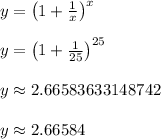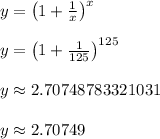
Mathematics, 06.10.2020 22:01 Wolfiid
PLEASE HELPPP Today in Algebra class, Ethan learned about the expressions (1+ 1/x)^x and e, but he can't remember if (1+1/x)^x gets closer and closer to e as x gets larger and larger, or if (1+1/x)^x get further and further away from e as x gets larger and larger. He's going to do a test to figure it out.
part l:What is the value of e to five decimal places?
Part II: What is the value of (1+1/x)^x when x = 5? Give your answer to five decimal places.
Part III: What is the value of (1+1/x)^x when x = 25? Give your answer to five decimal places.
Part IV: What is the value of (1+1/x)^x when x = 125? Give your answer to five decimal
places.
Part V: Is (1+1/x)^x getting closer and closer to e as x is getting larger and larger, or is getting further and further away from e as x is getting larger and larger?

Answers: 3


Another question on Mathematics

Mathematics, 21.06.2019 14:00
6people equally share 56 gummy worms. how many gummy worms does each person get? nine and one sixth gummy worms nine and two sixths gummy worms ten and one sixth gummy worms ten and two eighths gummy worms
Answers: 1


Mathematics, 21.06.2019 16:00
Answer asap ! the shortest path from point a to point b goes through a pond. to avoid the pond, you must walk straight 34 meters along one edge of the pond, then take a 90 degree turn, and again walk straight 41 meters along another edge of the pond to reach point b. about how many meters would be saved if it were possible to walk through the pond? a. 11 m b. 20 m c. 30.45 m d. 21.73 m
Answers: 1

Mathematics, 21.06.2019 16:20
Browning labs is testing a new growth inhibitor for a certain type of bacteria. the bacteria naturally grows exponentially each hour at a rate of 6.2%. the researchers know that the inhibitor will make the growth rate of the bacteria less than or equal to its natural growth rate. the sample currently contains 100 bacteria.the container holding the sample can hold only 300 bacteria, after which the sample will no longer grow. however, the researchers are increasing the size of the container at a constant rate allowing the container to hold 100 more bacteria each hour. they would like to determine the possible number of bacteria in the container over time.create a system of inequalities to model the situation above, and use it to determine how many of the solutions are viable.
Answers: 1
You know the right answer?
PLEASE HELPPP Today in Algebra class, Ethan learned about the expressions (1+ 1/x)^x and e, but he c...
Questions


Advanced Placement (AP), 20.10.2020 20:01

Mathematics, 20.10.2020 20:01

Mathematics, 20.10.2020 20:01

Biology, 20.10.2020 20:01

Law, 20.10.2020 20:01



Chemistry, 20.10.2020 20:01

History, 20.10.2020 20:01


Computers and Technology, 20.10.2020 20:01



Geography, 20.10.2020 20:01


Biology, 20.10.2020 20:01



Mathematics, 20.10.2020 20:01

 and round that to five decimal places to get
and round that to five decimal places to get 





